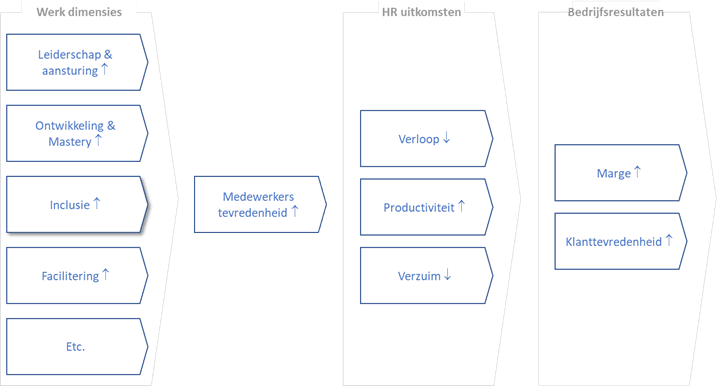Employee Satisfaction Survey, also referred to as Job Satisfaction Survey, is the mother of all employee surveys. Why? Satisfied employees are more productive, less absent, perform better, stay with the organization for longer and ensure higher customer satisfaction and more turnover, among other things. So, it makes sense that organizations want to know to what extent their employees are satisfied and what they can do to increase satisfaction among their employees.
However, the Employee Satisfaction Survey isn’t universally loved. It can be cumbersome for HR to facilitate one. It can take up a lot of your employees’ time to complete such a survey. Studying all the results can be a lot of work for the managers. And worst of all, they often don’t result in any changes.
Wouldn’t it be better not to conduct any Employee Satisfaction Surveys anymore? No, because the impact of employees’ satisfaction on the business results is far too important. Would it be better if they were conducted differently? Yes!
AnalitiQs helps organizations carry out Job Satisfaction Surveys in a smart way and uses data analysis to find all the right buttons to press.

What are Employee Satisfaction Surveys?
Essentially, Employee Satisfaction Surveys are about getting insight into the extent to which employees are happy at work and with their job. You only need a few survey questions to measure this.
So, why is the average Employee Satisfaction Survey so long?! There are basically two reasons for this:
- Firstly, the level of employee satisfaction doesn’t explain everything. Employee engagement and employee motivation play a role, too. Motivated employees are passionate about the work they do. Think of an enthusiastic teacher, for example. Engaged employees have a strong bond with the organization they work for. They feel a connection with the organization’s brand or purpose. You need slightly different questions to measure each of these three slightly different things. Most surveys want to gain insight into satisfaction as well as motivation and engagement, so the total number of questions in the questionnaire goes up.
- Secondly, organizations also want to know which factors influence the employee satisfaction, engagement and motivation. However, this list of factors can be very long, think for example of vitality, inclusiveness, facilities, leadership, etc. Many Employee Satisfaction Surveys include questions about lots of different potential factors, making the entire questionnaire extremely long.
In practice, the average Job Satisfaction Survey ends up being a questionnaire of around 50 questions, which is conducted once per year or every other year.
Why would I conduct an Employee Satisfaction Survey?
Is an infrequent, 50-question survey still of this day and age? No, it isn’t. Wouldn’t it be time to stop conducting Employee Satisfaction Surveys then? No, because the impact of employees’ satisfaction on the business results is far too important, as illustrated by the image below.
Employee satisfaction has a direct and indirect impact on the business results. Just like Finance keeps a close eye on turnover, costs and profits, and Marketing on customer satisfaction, HR must monitor (and influence) this important human indicator.

Roadmap to conduct Employee Satisfaction Surveys
Job Satisfaction Surveys can and must be done differently! AnalitiQs would like to share the following six ideas about it here.
- Consider carefully who’s going to complete your questionnaire and bear this in mind when you create it. For example, questionnaires that are aimed at higher-educated office staff can be difficult and/or irrelevant for lower-educated production workers.
- Ensure that your Employee Satisfaction Survey only includes topics that (1) will be followed up with policies and/or actions and (2) really influence employee satisfaction. A critical look and some statistical analysis can drastically reduce the length of your questionnaire.
- Make use of tried-and-tested marketing techniques. Spot checks and short check-ins once in a while (pulse surveys), for example. They allow you to keep a finger on the pulse throughout the year without burdening the organization too much.
- Ask respondents to explain their answers to key questions. These open responses can provide additional, deeper knowledge that can help you make better action plans and policies.
- Ensure that the organization makes the results available real-time in an online, interactive, visual dashboard to make the time between survey and action as short as possible and keep the momentum going.
- Swap control for trust. Stop operating based on action plans and start operating based on employee satisfaction scores instead, leaving the question of ‘how’ to the line. Offer help to teams that ask for it, or where and when you see that employee satisfaction falls behind.
Employee Satisfaction Surveys that are conducted in a smart way can help you increase employee satisfaction without excessive effort.
How do you increase employee satisfaction?
Smart Job Satisfaction Surveys, as described above, can help you increase employee satisfaction. In addition, HR can influence employee satisfaction via HR policies and by facilitating employees with things like a good onboarding programme, guidance in case of absenteeism and good transport arrangements.
But the best way to improve employee satisfaction is by getting the line on board. Get them to embrace it and start working on employee satisfaction together with the employees and HR. Such a movement usually starts at the top. If the example behaviour is demonstrated (and perhaps some targets are set), this will gradually trickle down to the lower management levels. This is how eventually, operating based on employee satisfaction will be embedded in the company DNA. It requires patience, but if it’s done right, the gain will be significant.
Is your organization ready to start improving the employee satisfaction? We’d be happy to discuss it with you.
Detailed Service Overview
HR Analysis
Equal Pay
Gender mobility
Absenteeism
Employee Segmentation
Employee Retention & Attrition
Engagement
Impact Measurement / ROI
Learning & Development
Management Development
Onboarding
Organisational Network
Performance
Process Mining
Productivity
Recruitment
Restructuring / Organizational-Development
Reward
Strategic Workforce Planning
Succession Management
Employee Surveys
Culture
Employee Satisfaction
Job Satisfaction
Inclusion
Onboarding
Employee Turnover
Diversity
Employee Community / Panel
Employee Engagement
Employee Commitment
Employee Journey
Employee Net Promotor Score (eNPS)
Employee Value Proposition (EVP)
Employee Enthusiasm
Labour Market
Labour Market Panel
Labour Market Positioning
Leadership
Manager Feedback
Personal Development
Pulse
Retention
Role Clarity
Sentiment
Strategic Alignment
Team Feedback
Total Reward Optimization
Voice of the Employee (VoE)
Work from home
Work Stress
Work Pressure
Capability Building
HR Analytics Strategy
HR Analytics Product Owner
HR Analytics Outsourcing
HR Academy
HR Dashboards
Absenteeism Dashboard
Integral HR Dashboard
Leadership Dashboard
Learning Dashboard
Recruitment Dashboard
Reward Dashboard
Talent Development Dashboard
Interested? Feel free to contact us!

